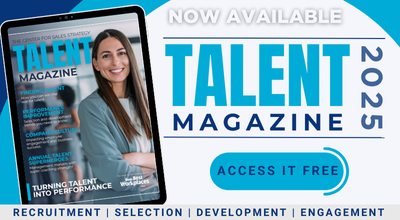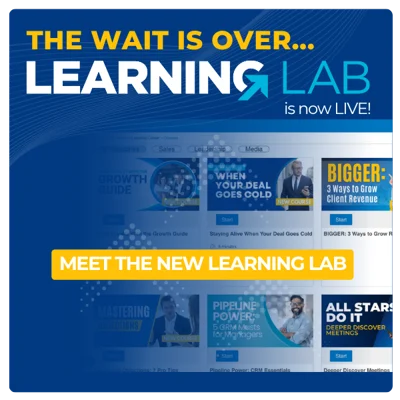
NBA Coach Phil Jackson once said, “The strength of the team is each individual member.” His thought holds true within your sales teams.
Each person on your team needs to have the right combination of talent and fit to be successful. But in this competitive job market, how can you attract top talent to your organization?
Separate Recruitment from Selection
The first key is to separate recruitment from selection.
- Recruitment is the act of finding people with a variety of talents, skills, and experiences that could potentially fill a role in your organization in the future.
- Selection is the act of searching through your talent bank to find the person with the right talents, skills, and experiences for the role you are filling.
Recruitment is proactive! That’s why we recommend adopting a “we’re always hiring” mindset. With this mindset, recruitment is happening all the time, whether you have an open position or not. Then, when you finally need to make a hire, you have a talented group of people sitting on the bench to pull from.
Recruiting is like prospecting in sales. Your target accounts are your future employees. Set aside time for recruitment the same way your Account Executives set aside time to prospect. If you make one deposit into your talent bank each week, at the end of the year, you’ll have 52 deposits!
Attracting top talent is challenging. It’s even more challenging if you don’t have a strong talent bank to pull from. Set a goal for talent bank deposits each month and hold yourself to that commitment. The most successful leaders develop consistent habits when it comes to recruitment.
Hunt Where the Game Is
You’ve set your recruitment goal. Now, where do you go to get started? If you want to attract top talent and find qualified candidates, you have to hunt in the right places. LinkedIn is one of the most widely-used platforms.
Actively engage with your LinkedIn network to help you become more visible. Be strategic about what you comment on and respond to comments of those who pique your interest as potential candidates. Getting the conversation started casually will help break the ice and give people the opportunity to explore your LinkedIn page as well.
Share blog posts. If your company has an active blog, share posts from your company that help others understand the culture and value of your organization. You can also share blogs from other companies and include a thought-provoking question at the top of your post to promote interaction.
If you use a validated talent assessment, share your assessment link and include hiring hashtags to draw more people to your post. And always make sure no one walks away empty-handed. Make it a habit to share a potential candidate’s Top Talent Report with them after they take the assessment.
Determine Your “Must Haves”
Talent bank deposits will come with many different combinations of talents, skills, and experiences.
Remember, talent is someone’s innate ability and can be measured through a validated talent assessment. Skills and experience are learned and gained over time. Determine your talent, skills, and experience “must haves” and identify the qualities that would be the icing on the cake if you’re able to find them.
For example, imagine you’re hiring someone who will primarily have a new business development role. A must-have may be the talent of Relationship, so they easily and quickly connect with others. It would be wonderful if they came in with a strong network of prospects and had a background knowledge of the industry, but those two things aren’t deal breakers. They could be acquired over time with your organization.
If you’ve held yourself to the goal you set for talent bank deposits, your “must-haves” will help you sort through the large number of candidates you’ve collected.
Explore Your Employer Brand
As you attract attention on LinkedIn and social media, potential candidates will certainly research your employer brand. Your employer brand refers to your company’s identity and your reputation as an employer.
It’s about the general perception of your company as a place to work. It also includes your Employee Value Proposition, which is the set of benefits that an employee receives in exchange for their talent, skills, and experience.
For example, Chick-Fil-A is widely known for having a strong employer brand. They are highly responsive and customer-focused, always delivering “service with a smile.”
As Amazon’s Jeff Bezos said, “Your brand is what other people say about you when you’re not in the room.” Take the time to find out what your current employer brand looks like.
Google your organization to see how you’re presenting yourself to your potential talent bank deposits. Find out what people think of your company and ensure it matches who you really are. The stronger your employer brand, the higher the quality of employees you will attract and retain.
Remember The Growth Formula
The Growth Formula is (Talent + Fit) x Investment = Growth.
Talent is someone’s innate ability to achieve success in a role. We often compare talent to land. Talent, like land, can’t be built or created, but it can be cultivated for growth. The more someone’s talents align with the necessary talents for a given role, the higher potential they have for success.
Fit has to do with how well someone will fit in a given role, with the team, with the company, and with your style of management. Personality, skills, and experiences all have an impact on fit. Just because someone has the innate talent to be successful in a job, doesn’t mean they’re the right fit for your personal style, your team dynamic, your clients, or your company culture. Don’t focus too much attention on how someone looks on paper. Pay just as much attention to fit.
When you get both talent and fit right, you are able to make an investment that will really pay off. Your investment includes all of the coaching, training, relationship development, and support that you provide your people.
Mastering the talent, fit, and investment pieces of the equation will help you achieve the growth you want. With the strength of the team lying in each individual member, growth within one person will help grow the organization overall.






